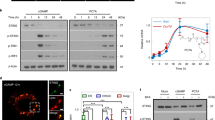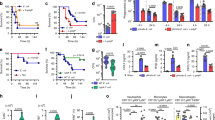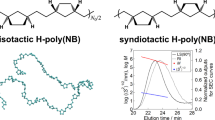Abstract
RECENT communications1–3 have called attention to the toxicity of poly I . poly C and noted the resemblance of some of these effects to known endotoxin effects. The fact that “although poly I . poly C and endotoxin share many similarities, they are not identical in action”1 is also documented by the ability of endotoxin and poly I . poly C to stimulate specific antibody responses when administered with an antigen4,5 whereas only endotoxin, but not poly I . poly C, can activate a large variety of nonspecific antibody responses when administered alone4,6. We previously furnished evidence4 indicating that the latter effect may be attributable to the ability of endotoxin to alter lymphocyte permeability, whereas the adjuvant action seems to result from cytotoxicity and the attendant release of endogenous stimulators5,7. Poly I . poly C, like endotoxin. pyran copolymer8, and a number of other polyanions, appears to damage cell membranes, specifically those of rnacrophages, and thereby can release a number of endogenous materials, including pyrogeii, interferon and stimulators of lymphocytes. Double stranded polynucleotides that are rather rapidly changed to oligomers in vivo (for example, poly A . poly U) seem to produce only transient effects on membranes and therefore produce strikingly less toxicity, no or little pyrogenicity, little elevation of interferon levels, but good stimulation of antibody-forming lymphocytes5. Thus the biological effects of polynucleotides seem to involve at least two events: those associated with the highly polymerized form and those produced by oligomers. Poly I . poly C appears to produce pronounced effects attributable to the polymer, namely cytotoxicity—possibly selective—and with it endotoxin-like effects. Current studies with macrophages and lymphocytes in vitro (unpublished data of L. Jimenez, D. Webb and W. B.) support this conclusion.
This is a preview of subscription content, access via your institution
Access options
Subscribe to this journal
Receive 51 print issues and online access
$199.00 per year
only $3.90 per issue
Buy this article
- Purchase on Springer Link
- Instant access to full article PDF
Prices may be subject to local taxes which are calculated during checkout
Similar content being viewed by others
References
Absher, M., and Stinebring, W. R., Nature, 223, 715 (1969).
Lindsay, H. L., Trown, P. W., Brandt, J., and Forbes, M., Nature, 223, 717 (1969).
Adamson, R. H., and Fabro, S., Nature, 223, 718 (1969).
Braun, W., Yajima, Y., and Nakano, M., in La Structure et les Effets Biologiques des Produits Bactériens Provenant des Germes Gram-Négatifs (Colloques No. 174, Editions du CNRS, Paris).
Braun, W., in Proc. VIth Intern. Cong. Chemotherapy (in the press).
Landy, M., and Weidanz, W. P., in Bacterial Endotoxins (edit. by Landy, M., and Braun, W.), 275 (Rutgers, New Brunswick, 1964).
Braun, W., and Firshein, W., Bacterial. Rev., 31, 83 (1967).
Braun, W., Regelson, W., Yajima, Y., and Ishizuka, M., Proc. Soc. Exp. Biol. and Med. (in the press).
Hedén, C.-G., Lindahl, T., and Braun, W., Acta Pathol. Microb. Scand., 57, 257 (1963).
Winchurch, R., and Braun, W., Nature, 223, 843 (1969).
Author information
Authors and Affiliations
Rights and permissions
About this article
Cite this article
BRAUN, W. Relationships between the Effects of Poly I . Poly C and Endotoxin. Nature 224, 1024–1025 (1969). https://doi.org/10.1038/2241024a0
Received:
Issue Date:
DOI: https://doi.org/10.1038/2241024a0
This article is cited by
-
Induction of specific antibodies to poly(ADP–ribose) in rabbits by double-stranded RNA, poly(A)·poly(U)
Nature (1978)
-
Immune Reactivity following Poly I·Poly C Treatment in Mice
Nature New Biology (1972)
-
Poly I·Poly C and endotoxins share immunosuppressive properties and increase the toxicity of α-amanitin and hexobarbital
Agents and Actions (1971)
Comments
By submitting a comment you agree to abide by our Terms and Community Guidelines. If you find something abusive or that does not comply with our terms or guidelines please flag it as inappropriate.



